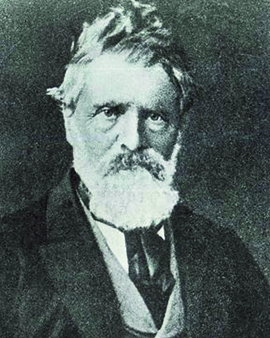


Peder Balke can justifiably be considered a pioneer of modernism. The Norwegian painter produced fascinating landscape paintings that at first glance could be mistaken for romantic nature studies. Yet his works are unusual and unique and - if at all - can really only be compared with the works of William Turner. Peder Balke created groundbreaking paintings in the 19th century on the way to modernism. They were created with brushes and wet-on-wet techniques, or scratched directly into the paint and kept in a color scale that is narrowly defined. The latter further enhances their dramatic character.
Wild mountain landscapes and sunsets over the roaring sea or quiet lakes in the forest: Balke's choice of motifs was not random. It was on a trip when he encountered the overwhelming natural beauty of northern Norway. He was actually attending the Royal School of Drawing and, having dodged conscription by moving to Christiania and scraping by as a house painter and decorative painter, had no money. But a fellow student persuaded him to visit him in Finnmark. A happy coincidence, as it turned out. For it shaped not only his life, but his entire career as an artist. He himself said of his stay that he had seen nothing comparable in his travels that had similarly gripped and moved him - either at home or abroad. People were in the sublime landscape only extras with a subordinate role.
Between 1846 and 1847 Balke then nevertheless left his beloved homeland and went to Paris. For it had come to his ears that King Louis Philippe showed a great interest in northern Norway and its beauties. As a young prince, the ruler had visited the North Cape incognito. In the firm conviction that the king was interested in his pictures, which should remind him of his experiences in the youth, Balke contacted the palace. He also succeeded in submitting some sketches. And indeed, His Majesty immediately ordered 30 paintings for his Palace of Versailles. Unfortunately, the February Revolution prevented the completion of the paintings. After all: Balke's sketches are still in the Louvre magazines.
So the king had liked what he saw. However, it took quite a while before Peder Balke's artistic work was appropriately appreciated by the art world and ennobled with a publication. Balke died as a heavily indebted man after a stroke. Before that, he had unsuccessfully campaigned several times for the introduction of a pension fund for workers and a widow's and disability pension, for he was not only a landscape painter, but in later years also a socio-political activist. The artist, who was born in 1804, only found appropriate recognition in the 20th century: it was already the 1990s when the Danish painter Per Kirkeby wrote a book about the loner.

Peder Balke can justifiably be considered a pioneer of modernism. The Norwegian painter produced fascinating landscape paintings that at first glance could be mistaken for romantic nature studies. Yet his works are unusual and unique and - if at all - can really only be compared with the works of William Turner. Peder Balke created groundbreaking paintings in the 19th century on the way to modernism. They were created with brushes and wet-on-wet techniques, or scratched directly into the paint and kept in a color scale that is narrowly defined. The latter further enhances their dramatic character.
Wild mountain landscapes and sunsets over the roaring sea or quiet lakes in the forest: Balke's choice of motifs was not random. It was on a trip when he encountered the overwhelming natural beauty of northern Norway. He was actually attending the Royal School of Drawing and, having dodged conscription by moving to Christiania and scraping by as a house painter and decorative painter, had no money. But a fellow student persuaded him to visit him in Finnmark. A happy coincidence, as it turned out. For it shaped not only his life, but his entire career as an artist. He himself said of his stay that he had seen nothing comparable in his travels that had similarly gripped and moved him - either at home or abroad. People were in the sublime landscape only extras with a subordinate role.
Between 1846 and 1847 Balke then nevertheless left his beloved homeland and went to Paris. For it had come to his ears that King Louis Philippe showed a great interest in northern Norway and its beauties. As a young prince, the ruler had visited the North Cape incognito. In the firm conviction that the king was interested in his pictures, which should remind him of his experiences in the youth, Balke contacted the palace. He also succeeded in submitting some sketches. And indeed, His Majesty immediately ordered 30 paintings for his Palace of Versailles. Unfortunately, the February Revolution prevented the completion of the paintings. After all: Balke's sketches are still in the Louvre magazines.
So the king had liked what he saw. However, it took quite a while before Peder Balke's artistic work was appropriately appreciated by the art world and ennobled with a publication. Balke died as a heavily indebted man after a stroke. Before that, he had unsuccessfully campaigned several times for the introduction of a pension fund for workers and a widow's and disability pension, for he was not only a landscape painter, but in later years also a socio-political activist. The artist, who was born in 1804, only found appropriate recognition in the 20th century: it was already the 1990s when the Danish painter Per Kirkeby wrote a book about the loner.
Page 1 / 1






